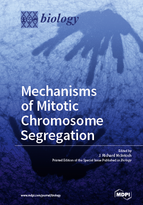Mechanisms of Mitotic Chromosome Segregation
A special issue of Biology (ISSN 2079-7737).
Deadline for manuscript submissions: closed (1 October 2016) | Viewed by 190666
Special Issue Editor
Interests: Mechanisms of mitotic chromosome motion, microtubule dynamics, spindle structure, motor enzymes, force generation by microtubule dynamics
Special Issue Information
Dear Colleagues,
This volume focuses on the mechanisms by which a mitotic spindle interact with a replicated genome to assure its accurate segregation to daughter cells at the time of cell division. The following subjects are treated by world-renown specialists: 1) Foundations of modern research on mitotic mechanisms; 2) Kinetochore structure; 3) Kinetochore assembly and function; 4) Spindle assembly; 5) Spindle assembly in plant cells; 6) Chromosome congression to the metaphase plate; 7) The spindle assembly checkpoint; 8) Correcting mitotic errors; 9) Anaphase A; 10) Anaphase B.
Prof. Dr. J. Richard McIntosh
Guest Editor
Manuscript Submission Information
Manuscripts should be submitted online at www.mdpi.com by registering and logging in to this website. Once you are registered, click here to go to the submission form. Manuscripts can be submitted until the deadline. All submissions that pass pre-check are peer-reviewed. Accepted papers will be published continuously in the journal (as soon as accepted) and will be listed together on the special issue website. Research articles, review articles as well as short communications are invited. For planned papers, a title and short abstract (about 100 words) can be sent to the Editorial Office for announcement on this website.
Submitted manuscripts should not have been published previously, nor be under consideration for publication elsewhere (except conference proceedings papers). All manuscripts are thoroughly refereed through a single-blind peer-review process. A guide for authors and other relevant information for submission of manuscripts is available on the Instructions for Authors page. Biology is an international peer-reviewed open access monthly journal published by MDPI.
Please visit the Instructions for Authors page before submitting a manuscript. The Article Processing Charge (APC) for publication in this open access journal is 2700 CHF (Swiss Francs). Submitted papers should be well formatted and use good English. Authors may use MDPI's English editing service prior to publication or during author revisions.
Keywords
- mitosis
- chromosome segregation
- mitotic spindle
- microtubule
- kinetochore
- centrosome
- spindle assembly checkpoint
- anaphase
- motor enzyme
- kinesin
- dynein
- microtubule dynamics







